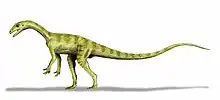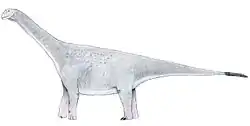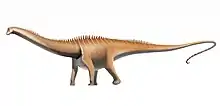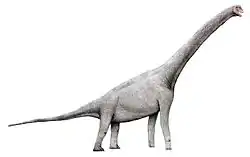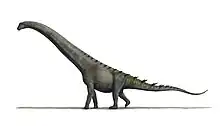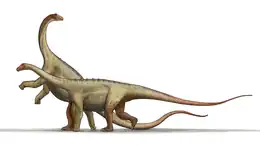| Brasilotitan Temporal range: Late Cretaceous, | |
|---|---|
| Scientific classification | |
| Domain: | Eukaryota |
| Kingdom: | Animalia |
| Phylum: | Chordata |
| Clade: | Dinosauria |
| Clade: | Saurischia |
| Clade: | †Sauropodomorpha |
| Clade: | †Sauropoda |
| Clade: | †Macronaria |
| Clade: | †Titanosauria |
| Clade: | †Lithostrotia |
| Genus: | †Brasilotitan Machado et al., 2013 |
| Species: | †B. nemophagus |
| Binomial name | |
| †Brasilotitan nemophagus Machado et al., 2013 | |
Brasilotitan (meaning "Brazil giant") is a genus of titanosaurian sauropod dinosaur from the Late Cretaceous (early Maastrichtian) Adamantina Formation of Brazil. The type species is Brasilotitan nemophagus.
Discovery and naming
In 2000, William R. Nava collected the partial skeleton of a sauropod along a road in São Paulo state near Presidente Prudente city. In 2013, a team of researchers, including Nava and led by Elaine B. Machado, described the remains as a new genus and species of sauropod, Brasilotitan nemophagus. The genus name refers to its discovery in Brazil and to the Titans of Greek mythology, and the species epithet combines the Greek words némos "pasture, wood" and phagos "to eat", in reference to its herbivorous diet.[1]
Fossil record
Fossils of Brasilotitan nemophagus are known from the Adamantina Formation. The holotype specimen, MPM 125R, is a partial skeleton that consists of the right dentary, two partial cervical vertebrae, a partial sacrum, two fragments of the pelvis pertaining to the ilium and ischium, and an ungual phalanx. A tooth fragment that was found nearby, MPM 126R, may belong to the same skeleton. The holotype specimen was likely scavenged by theropods before being buried, as some of the bones show puncture marks and theropod teeth were found alongside the skeleton. [1]
Material and morphology
Brasilotitan was small for a sauropod, probably less than 12 metres (39 ft) long.[2] As in several other titanosaurs, the mandible is L-shaped, producting a squared-off snout. The symphyseal region of the dentary is slightly twisted medially, a feature never recorded before in any titanosaur.[1]
Phylogeny
Although the phylogenetic position of Brasilotitan is difficult to establish, the new species is neither basal nor a derived member of Titanosauria. Based on lower jaw morphology, it appears to be closely related to Antarctosaurus and Bonitasaura. This discovery enriches the titanosaur diversity of Brazil and provides further new anatomical information on the lower jaws of those herbivorous dinosaurs.[1]
Phylogenetic analyses have found Brasilotitan to be the sister taxon of another Brazilian titanosaur, Uberabatitan.[3][4] Filippi et al. included Brasilotitan in what they called "Clade A", a grouping of titanosaurs with square jaws.[4]
References
- 1 2 3 4 Elaine B. Machado; Leonardo dos S. Avilla; William R. Nava; Diogenes de A. Campos; Alexander W. A. Kellner (2013). "A new titanosaur sauropod from the Late Cretaceous of Brazil". Zootaxa. 3701 (3): 301–321. doi:10.11646/zootaxa.3701.3.1. PMID 26191585.
- ↑ González Riga, Bernardo J.; Casal, Gabriel A.; Fiorillo, Anthony R.; Ortiz David, Leonardo D. (2022). "Taphonomy: Overview and New Perspectives Related to the Paleobiology of Giants". In Otero, Alejandro; Carballido, José L.; Pol, Diego (eds.). South American Sauropodomorph Dinosaurs. Cham: Springer International Publishing. pp. 541–582. ISBN 978-3-030-95958-6.
- 1 2 Filippi, Leonardo S.; Juárez Valieri, Rubén D.; Gallina, Pablo A.; Méndez, Ariel H.; Gianechini, Federico A.; Garrido, Alberto C. (2023-10-30). "A rebbachisaurid-mimicking titanosaur and evidence of a Late Cretaceous faunal disturbance event in South-West Gondwana". Cretaceous Research. 154: 105754. doi:10.1016/j.cretres.2023.105754. ISSN 0195-6671.
